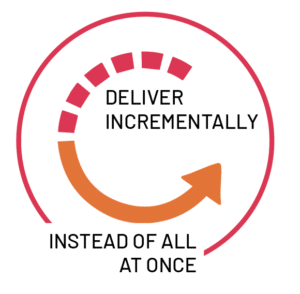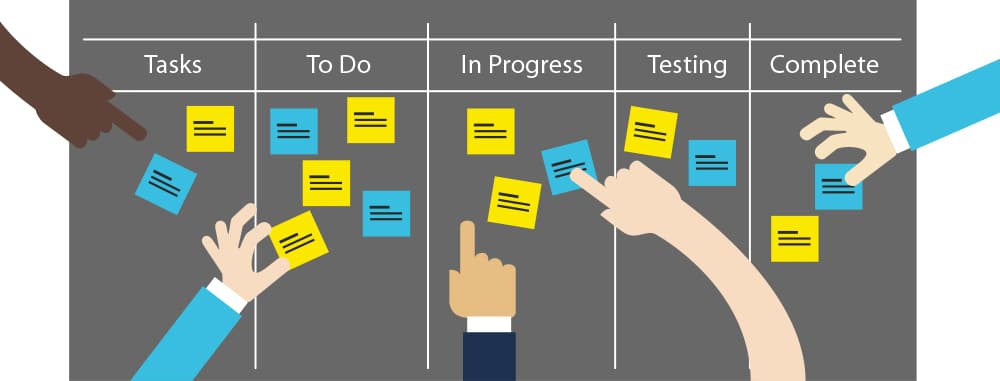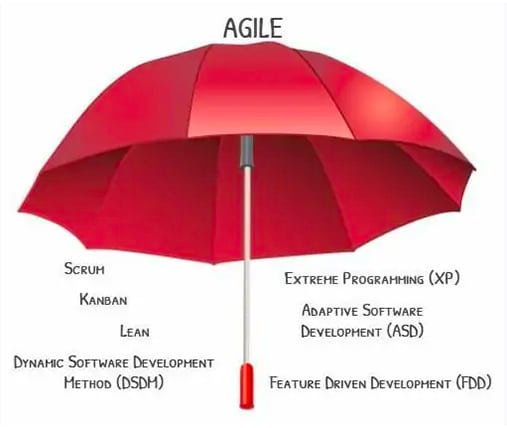What is Agile?
Agile is an iterative approach to project management, software development, and more recently to product development too. Agile helps teams deliver value to their customers faster and with fewer headaches.

Despite the growing popularity of agile project management in the field of IT projects, it has not yet been established in other types of projects (engineering, research & development, organization of events.
However, we cannot say that certain agile practices cannot be utilized for projects that are still carried out in the traditional way.
The main differences of the traditional and agile approach can be classified into four groups: requirements & specifications (the level of detail at the beginning of the project), project scheduling (iterations and a rough schedule at the planning phase), teamwork (self-organized teams, daily meetings), and client collaboration (the representative of the client is a regular team member).
Why choose Agile?
We choose agile to respond to changes in the marketplace or feedback from customers quickly without derailing a year’s worth of plans. “Just enough” planning and shipping in small, frequent increments let your team gather feedback on each change and integrate it into plans at a minimal cost.
But it’s not just a numbers game—first and foremost, it’s about people. As described by the Agile Manifesto, authentic human interactions are more important than rigid processes. Collaborating with customers and teammates is more important than predefined arrangements. And delivering a working solution to the customer’s problem is more important than hyper-detailed documentation.
An agile team unites under a shared vision, then brings it to life the way they know is best. Each group sets its own standards for quality, usability, and completeness. Their “definition of done” then informs how fast they’ll churn the workout. Although it can be scary at first, company leaders find that when they put their trust in an agile team, that team feels a greater sense of ownership and rises to meet (or exceed) management’s expectations.
The main concepts of Agile
- Work as a team and continually communicate in the group.
- You can make mistakes and have to fix them quickly. Ready to change And always adapting.
- Gradually evolve little by little The work is delivered and updates continuously. Not waiting for a big project And sending at once.
- Reduce unnecessary steps and give value as much as possible.
Agile Manifesto
The Agile Manifesto is a statement of core values and principles for software development. The Agile Manifesto for software development was set up in 2001, and it is a declaration of 4 vital rules and 12principles that serve as a guide for agile software development. It was created by 17 professionals who already practiced agile methods such as XP, DSDM, SCRUM, FDD, etc., gathered in the snowy mountains of the US state of Utah, convened by Kent Beck.
4 Core values of Agile Manifesto
- Individuals and interactions over processes and tools: The first value emphasizes teamwork and communication. We must understand that software development is a human activity and that interaction between people is vital. Tools are an essential part of software development, but making great software depends on teamwork, regardless of the team’s devices.
- Working software over comprehensive documentation: Documentation has its place and can be a great resource or reference for users and coworkers alike. However, software development’s primary goal is to develop software that offers business benefits rather than extensive documentation.
- Customer collaboration over contract negotiation: Development teams must work closely and communicate with their customers frequently. By listening to and getting feedback, teams will understand what all stakeholders want.
- Responding to change over following a plan: Changes are a reality in Software development, the fact that your Software process should reflect. A project plan must be flexible enough to change, as the situation demands.
12 Agile Principle
- The highest priority is to satisfy the customer through early and continuous delivery of value.
- Welcome changing requirements, even late in development. Agile processes harness change for the customer’s competitive advantage.
- Deliver working software frequently, from a couple of weeks to a couple of months, with a shorter time scale preference.
- Business people and developers must work together daily throughout the project.
- Build projects around motivated individuals. Give them the environment and support they need, and trust them to get the job done.
- The most efficient and effective method of conveying information to and within a development team is face-to-face conversation.
- Working software is the primary measure of progress.
- Agile processes promote sustainable development. The sponsors, developers, and users should be able to maintain a constant pace indefinitely.
- Continuous attention to technical excellence and good design enhances agility.
- Simplicity–the art of maximizing the amount of work not done–is essential.
- The best architectures, requirements, and designs emerge from self-organizing teams.
- The team reflects on becoming more effective at regular intervals, then tunes and adjusts its behavior accordingly.
Agile Project Management
Agile Project management is an incremental method of managing design and building activities that have been incorporated in various fields such as Engineering, Information Technology, and other business areas that strive to implement new service expansion in a highly flexible and interactive manner.
Agile project management :
Offers a simple framework supporting communication between team members and reflecting on the potential lag in work faced earlier. Companies using traditional waterfall planning have migrated to the agile way of improvement. Waterfall builds software in a phased series for the first time for real feedback occurring right before release. Agile makes software incrementally using small repetitions to keep growth regulated with changing business needs. We can’t go back in phases with the waterfall method, but it is possible with Agile.
Definition of Agile Project Management
Agile Development is a term for several iterative and incremental software development methodologies. Although each of the agile methods is unique in its specific approach, they all share a shared vision and core values. There are two approaches in agile development, namely:
- Lightweight approach
- Fuller approach
The lightweight approach consists of several methods such as Scrum, Lean software development, Kanban (process + method), Continuous Integration, Continuous delivery, Extreme programming, and Feature-driven development.
The whole approach is used to deploy for more than one team. Features such as Scrum of Scrums, Scrum at Scale, Large scale-scrum, Scaled agile framework, Disciplined agile delivery, unified Agile process are part of the whole approach.
Key Agile Methodologies
Agile is an umbrella term for several methods and practices. Let’s look at some of the popular methodologies:
-
- Scrum
- Extreme Programming (XP)
- Adaptive Software Development (ASD)
- Dynamic Software Development Method (DSDM)
- Feature Driven Development (FDD)
- Kanban
- Behavior Driven Development (BDD)
Summary
There are a variety of different models and development methodologies based on Agile principles. In recent years, there has been a growing list of organizations who credit the methods with their success. Some of the biggest names in media, technology, finance, and even some National Government agencies have adopted and praised the efficiency of Agile.
The agile approach brings many benefits to both the client and to the project team, and that the approach would be useful for all types of projects, however, the practice has not yet confirmed their foresight and efforts.
Despite our doubts that the agile approach will be widely used in the future, we believe that certain agile practices can be utilized for product development projects that nowadays will be basically still carried out in the traditional way.
Get in touch with us and we will help you with the transformation.




Leave a Reply